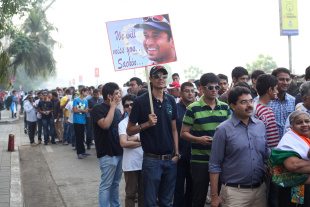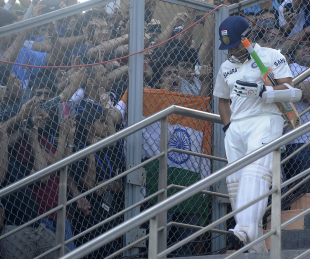India v West Indies, 2013-14
Nagraj Gollapudi

|
|||
|
Related Links
Series/Tournaments:
West Indies tour of India
Teams:
India
| West Indies
|
|||
Test matches (2): India 2, West Indies 0
One-day internationals (3): India 2, West Indies 1
This was not so much a series as a pilgrimage - and all in honour of one man. In fact, the series was not even supposed to be happening: according to the schedule, West Indies had not been due to arrive in India until October 2014.
That they were asked to advance their travels by 12 months was primarily because the BCCI wanted to give Sachin Tendulkar a fond farewell in his 200th Test. The preamble was far from smooth.
The Indian selectors had been growing restless and, keeping in mind future overseas assignments, were desperate to test out new batsmen. Not-so-young pretenders such as Rohit Sharma and Ajinkya Rahane had been kicking their heels for too long. But, as usual, all eyes were on Tendulkar.
In the 21 Tests after January 2011, when he had last scored a century, his average had been 31. He still could muster fifties every now and then, but his reflexes were in terminal decline, and bowlers were breaching his defences. News leaked out that chairman of selectors Sandeep Patil had told BCCI president N. Srinivasan that Tendulkar's time was up; Patil called the reports "nonsense". But Tendulkar understood it was over.
He conveyed that message to the BCCI, and two Tests against West Indies were quickly put in place. So the expectation - enticing to many - that Tendulkar's career would end at the turn of the year in South Africa, against the world's No. 1 Test side, was scotched. To South Africa's understandable annoyance, the BCCI promptly halved India's tour there, in part to find room for Tendulkar's home jamboree.
And so the circus moved from Lahli in northern India, venue of Tendulkar's final Ranji Trophy appearance, to Kolkata in the east, before arriving on the west coast in Mumbai, his home city. His reputation had been constructed using bricks of purity. He was a man who would grow to become best batsman, captain, senior statesman, mentor and inspiration. Thousands of devotees turned up at the three venues to pay homage.
He did not disappoint them. In the dusty village of Lahli, on a ground surrounded by rice and cane fields, Tendulkar came out to bat for Mumbai in a tricky run-chase against Haryana. On a green pitch, in swinging conditions, against nagging medium-pacers, he slowed the pace of the game, steadily transferring the advantage towards Mumbai. He finished undefeated on 79.
That innings boded well for the Tests. However, Tendulkar was sawn off in Kolkata by a doubtful lbw decision. It was his only innings of the game, which was over by the third evening - catching the local authorities off guard. The Bengal chief minister had to cancel all her appointments and rush to the ground to felicitate Tendulkar. There were plans for 199kg of rose petals to be showered across the stadium's expanse to symbolise his 199th Test, and for 65,000 Tendulkar face masks to be distributed among the crowd - but time ran out. The Cricket Association of Bengal had invited Brian Lara, his one equal as a batsman in the 1990s, to be part of the celebrations. But Lara was reportedly stranded in mid-air when the match finished.

|
|||
Mistakes were made, too. M. S. Dhoni pointed out that Tendulkar's first name has been misspelt as "Sachine" above his portrait - painted by the Bengali artist Jogen Chowdhury - which hung from the High Court End. On the first day, the electronic scoreboard referred to his wife as "Mr Anjali Tendulkar" for nearly half an hour before the error was corrected. The men responsible were given a fearsome rebuke by a CAB official.
In Mumbai, Tendulkar finally regained his footing. He walked out after two wickets fell in an over to Shane Shillingford's off-breaks, returned unbeaten on 38 at the end of the first day, and next morning briefly dazzled a full house, crossing 50 with an exquisite straight-drive, one of his signature strokes. Such fluency and command led all to assume that a valedictory hundred was a given. The stands were swelling as the countdown began. But just after the first drinks break, Tendulkar tried to cut Narsingh Deonarine's off-spin, and Darren Sammy clung on at slip. A momentary hush wrapped around the ground like a cold blanket. For one last time India's show-stopper walked back, head bowed, eyes full of tears.
West Indies had arrived in reasonable nick, having won their last three Test series 2-0, admittedly against New Zealand, Bangladesh and Zimbabwe. But they had not played a Test since March, and they had little more planned than a team-building exercise in Miami ahead of their tour of New Zealand when they got the call from their impoverished board. Suddenly, they were upping sticks for India. Compelled to play cheerleaders at Tendulkar's carnival,West Indies merrily donned the pom-poms - rather too merrily, for some tastes. They could not keep either Test alive even for three days, occupying just 234.3 overs across four innings, and mustering two individual half-centuries. Their batsmen averaged 18 (their fourth-lowest in a series) and their bowlers 48. Shillingford was the only player to hold his own, and joined Charlie "Terror" Turner, Tom Richardson and Alec Bedser as bowlers to have taken five successive five-wicket hauls in Tests. But so easily did West Indies collapse that he bowled in only two innings. Their former captain Clive Lloyd declared: "They are drunk on Twenty20 cricket."
Worse was to follow, when Shillingford and Marlon Samuels were reported for suspect actions by English umpires Richard Kettleborough and Nigel Llong at Mumbai. Both men were sent to Perth for testing, but Shillingford failed to convince the ICC that his stock off-break met the requirements, and was suspended from bowling for the second time in his international career; Samuels was barred from bowling his quicker delivery. Some questioned the West Indies Cricket Board's failure to hire a specialist spin-bowling coach. India's biggest gains were Rohit Sharma and Mohammed Shami, debutants and match-winners at Kolkata: Sharma with a big century, Shami a nine wicket haul.
The most telling images of the series were of Shami uprooting the stumps to signal the end of both matches. His coaches told of how, as a youngster, he would wait for training to finish so he could take the old red balls home to polish them and cultivate reverse swing, a skill he had refined with Wasim Akram at Kolkata Knight Riders. He consistently hit 85mph,
darting the ball in or out after pitching, so the batsmen did not know whether to look for the shine or pay attention to the seam. Shami's match figures of nine for 118 in the First Test were the best by an Indian seamer on debut. Yet the most profound moment of all followed Tendulkar's final dismissal. After observing a mournful silence, then a standing ovation, the crowd did not flood out of the ground - as had been the custom in India whenever his wicket fell. Instead, they stayed to appreciate the calmness of Cheteshwar Pujara, the daring of Virat Kohli, the wristiness of Sharma and the pace of Shami. Deep down, Tendulkar would have been proud: it was he who had taught the youngsters to dream big.
The India of the 1990s, which had relied on him, was a chapter from the previous millennium. All these young men, most of them toddlers when he first wore the India cap, had grown into match-winners. On the eve of the series, Dhoni said he and his troops would do their bit, which implicitly suggested Tendulkar would have to do his bit too. Both parties honoured their word.
Match reports for
Tour Match: Uttar Pradesh v West Indians at Jadavpur Uni, Oct 31-Nov 2, 2013
Scorecard
1st Test: India v West Indies at Eden Gardens, Nov 6-8, 2013
Report |
Scorecard
2nd Test: India v West Indies at Wankhede, Nov 14-16, 2013
Report |
Scorecard
1st ODI: India v West Indies at Kochi, Nov 21, 2013
Report |
Scorecard
2nd ODI: India v West Indies at Visakhapatnam, Nov 24, 2013
Report |
Scorecard
3rd ODI: India v West Indies at Kanpur, Nov 27, 2013
Report |
Scorecard

